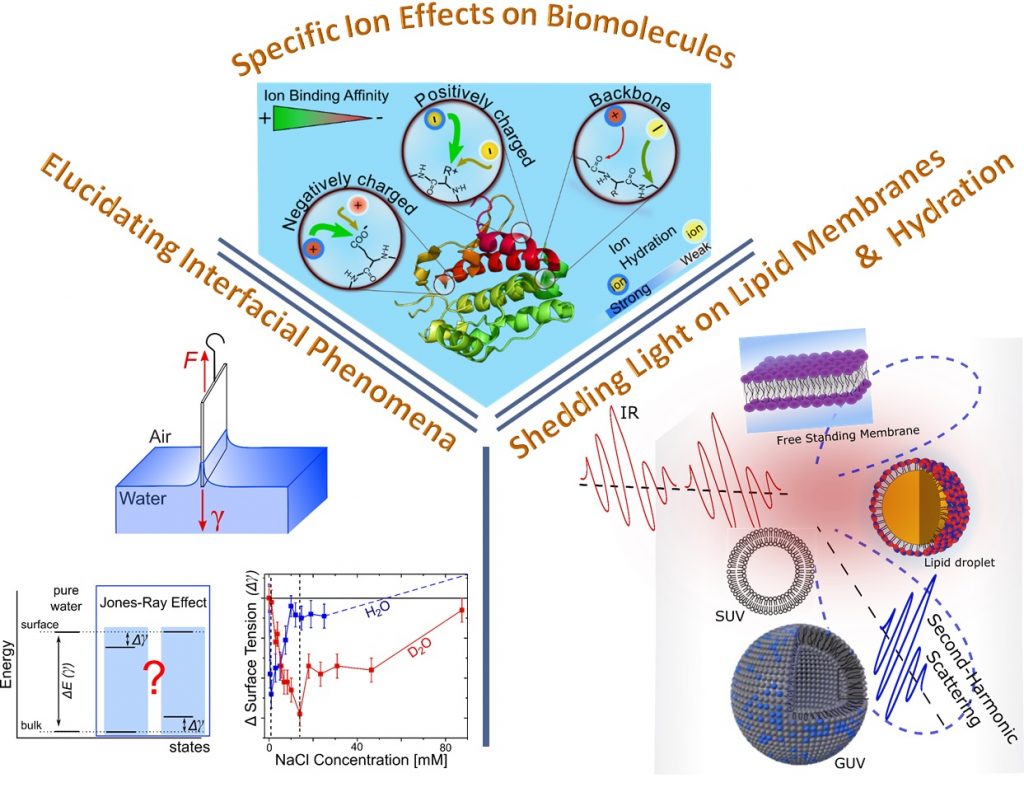In a recent collaborative work, the molecular mechanism of the interactions between macromolecules and Hofmeister cations is elucidated. Although all metal cations are on average depleted from the macromolecule/water interface, more strongly hydrated metal cations (Ca2+, Mg2+) are able to locally accumulate around the amide oxygen. Such weakly favorable interactions aided partially offset of the salting-out effect. Surprisingly, the cations approach the interface together with chloride counter anions as solvent-shared ion pairs. (read more…)
Author: ORGadmin
A new article on exploring the surface propensity of molecular ions in ionic liquid mixtures.
In this study, in collaboration with Suzer Lab, we have demonstrated the surface propensity of TFSI anion over BF4 anion in mixture of ionic liquids. We have developed a new methodology including measurements of angle-resolved X-Ray photoelectron spectroscopy and contact angle along with a signal attenuated modeling to report on the specific surface enrichment of different species in liquid mixtures. This new multi-instrumental method is applicable to various liquid systems. (Read more)
Ferhat joins to Okur lab
Umay joins our team.
A short communication paper is accepted in Journal of Chemical Physics
In this communication, we discussed the stability criteria for bare oil nanodroplets. Experimental data has been provided to show the necessity for high electrophoretic mobility to overcome the van-der-Waals attraction between hydrophobic oil nanodroplets in water.
Dr. Gülsüm Gündogdu joined Okur Lab.
Article published at Communication Chemisty
The transient domains of ordered water induced by divalent cations (Mg2+, Ca2+ and Sr2+) lead to lipid membrane curvature fluctuations. A convincing evidence for the direct connection between lipid hydration structure and macroscopic dynamic curvature fluctuations. (Learn more …)
Dr. Okur is awarded the Marie-Curie Fellowship grant.
Dr. Okur has been awarded the Marie Sklodowska-Curie Action (MSCA) Individual Fellowship grant for two years. This is the 9th such grant awarded to a researcher at Bilkent.
Dr. Okur has proposed to elucidate chemical processes occurring at biological surfaces by probing the adjacent interfacial water molecules using nonlinear optical techniques. While the leading scientific approach to investigating biological surfaces has been incorporating dye molecules to probe their optical response, Dr. Okur has adapted an alternative, non-invasive approach: employing water molecules as a probe to report on the chemical processes at these biosurfaces. The underlying motivation is that biological surfaces, being naturally bathed in aqueous solutions, are always in contact with the adjacent water molecules; such a method can thus be applied to almost all biosurfaces.
Dr. Okur gave a talk at NanoTR 15
Prof. Halil Okur gave a talk at NanoTR 15 which was held in Antalya, Turkiye. His talk was entitled “Exploring Biological Nano-Droplets with Nonlinear Scattering.”
Research overview

